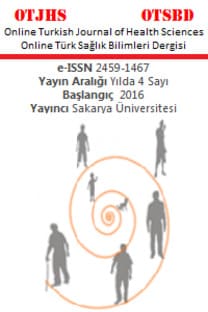COVID-19 Tedavisinde Kullanılan Bazı İlaçların Reseptör İlişkilerinin Modelleme Çalışmaları ile Değerlendirilmesi
COVID-19 ilaçları, meme kanseri, moleküler kenetlenme, reseptör
Evaluation of Receptor Relationships of Some Drugs Used in the Treatment of COVID-19 by Modeling Studies
Breast cancer, COVID-19 drugs, molecular docking, receptor,
___
- 1. Chakraborty I, Maity P. COVID-19 outbreak: Migration, effects on society, global environment and prevention. Sci Total Environ. 2020;728:138882. doi:10.1016/j.scitotenv.2020.138882
- 2. Potì F, Pozzoli C, Adami M, Poli E, Costa LG. Treatments for COVID-19: Emerging drugs against the coronavirus. Acta Bio Medica Atenei Parmensis. 2020;91(2):118-136. doi:10.23750/abm.v91i2.9639
- 3. Taher M, Tik N, Susanti D. Drugs intervention study in COVID-19 management. Drug Metab Pers Ther. 2021;36(2):87-98. doi:10.1515/dmdi-2020-0173
- 4. Vohra M, Sharma AR, Satyamoorthy K, Rai PS. Pharmacogenomic considerations for repurposing of dexamethasone as a potential drug against SARS-CoV-2 infection. J Pers Med. 2021;18(4):389-398. doi:10.2217/pme-2020-0183
- 5. Ciobotaru OR, Lupu MN, Rebegea L, et al. Dexamethasone-chemical structure and mechanisms of action in prophylaxis of postoperative side effects. Rev Chim. 2019;70(3):843-847. doi:10.37358/RC.19.3.7017
- 6. Joshi S, Parkar J, Ansari A, et al. Role of favipiravir in the treatment of COVID-19. Int J Infect Dis. 2021;102:501-508. doi:10.1016/j.ijid.2020.10.069
- 7. Coomes EA, Haghbayan H. Favipiravir, an antiviral for COVID-19. J Antimicrob Chemother. 2020;75(7):2013-2014. doi:10.1093/jac/dkaa171
- 8. Lodangi N, Thawani V. Favipiravir in COVID-19. The Antiseptic. 2020;117:16-17.
- 9. Yao X, Ye F, Zhang M, et al. In vitro antiviral activity and projection of optimized dosing design of hydroxychloroquine for the treatment of Severe Acute Respiratory Syndrome Coronavirus 2 (SARS-CoV-2). Clin Infect Dis. 2020;71(15):732-739. doi:10.1093/cid/ciaa237
- 10. Schrezenmeier E, Dörner T. Mechanisms of action of hydroxychloroquine and chloroquine: implications for rheumatology. Nat Rev Rheumatol. 2020;16(3):155-166. doi:10.1038/s41584-020-0372-x
- 11. Nakayama T, Sugano Y, Yokokawa T, et al. Clinical impact of the presence of macrophages in endomyocardial biopsies of patients with dilated cardiomyopathy. Eur J Heart Fail. 2017;19(4):490-498. doi:10.1002/ejhf.767
- 12. Iqbal BM, Buch A. Hormone receptor (ER, PR, HER2/neu) status and proliferation index marker (Ki-67) in breast cancers: Their onco-pathological correlation, shortcomings and future trends. Med J DY Patil Univ. 2016;9:674-679. doi:10.4103/0975-2870.194180
- 13. Akdemir A, Angeli A, Göktaş F, Eraslan Elma P, Karalı N, Supuran CT. Novel 2-indolinones containing a sulfonamide moiety as selective inhibitors of candida β-carbonic anhydrase enzyme. J. Enzyme Inhib Med Chem. 2019;34(1):528-531. doi:10.1080/14756366.2018.1564045
- 14. Hanwell MD, Curtis DE, Lonie DC, Vandermeersch T, Zurek E, Hutchison GR. Avogadro: an advanced semantic chemical editor, visualization, and analysis platform. J Cheminform. 2012;4:17. doi:10.1186/1758-2946-4-17
- 15. Trott O, Olson AJ. AutoDock Vina: improving the speed and accuracy of docking with a new scoring function, efficient optimization, and multithreading. J Comput Chem. 2010;31(2):455-461. doi:10.1002/jcc.21334
- 16. Gavriatopoulou M, Ntanasis-Stathopoulos I, Korompoki E, et al. Emerging treatment strategies for COVID-19 infection. Clin Exp Med. 2021;21(2):167-179. doi:10.1007/s10238-020-00671-y
- 17. Sabe VT, Ntombela T, Jhamba LA, et al. Current trends in computer aided drug design and a highlight of drugs discovered via computational techniques: A review. Eur J Med Chem. 2021;224:113705. doi:10.1016/j.ejmech.2021.113705
- 18. Akinlalu AO, Chamundi A, Yakumbur DT, et al. Repurposing FDA-approved drugs against multiple proteins of SARS-CoV-2: An in silico study. Sci Afr. 2021;13:e00845. doi:10.1016/j.sciaf.2021.e00845
- 19. Tiwari G, Chauhan MS, Sharma D. Systematic in silico studies of corticosteroids and its binding affinities with glucocorticoid receptor for Covid-19 treatment: Ab-initio, molecular docking and MD simulation studies. Polycycl Aromat Compd. 2022. doi:10.1080/10406638.2022.2092878
- 20. Celı̇k I, Onay-Besı̇kcı̇ A, Ayhan-Kilcigı̇l G. Approach to the mechanism of action of hydroxychloroquine on SARS-CoV-2: a molecular docking study. J Biomol Struct Dyn. 2021;39(15):5792-5798. doi:10.1080/07391102.2020.1792993
- 21. Khelfaoui H, Harkati D, Saleh BA. Molecular docking, molecular dynamics simulations and reactivity, studies on approved drugs library targeting ACE2 and SARS-CoV-2 binding with ACE2. J Biomol Struct Dyn. 2021;39(18):7246-7262. doi:10.1080/07391102.2020.1803967
- 22. Wang Y, Li P, Rajpoot S, et al. Comparative assessment of favipiravir and remdesivir against human coronavirus NL63 in molecular docking and cell culture models. Sci Rep. 2021;11:23465. doi:10.1038/s41598-021-02972-y
- 23. Shi TT, Yu XX, Yan LJ, Xiao HT. Research progress of hydroxychloroquine and autophagy inhibitors on cancer. Cancer Chemother Pharmacol. 2017;79(2):287-294. doi:10.1007/s00280-016-3197-1
- 24. Murata H, Khattar NH, Gu L, Li GM. Roles of mismatch repair proteins hMSH2 and hMLH1 in the development of sporadic breast cancer. Cancer Lett. 2005;223(1):143-150. doi:10.1016/j.canlet.2004.09.039
- 25. Banin Hirata BK, Oda JM, Losi Guembarovski R, Ariza CB, de Oliveira CE, Watanabe MA. Molecular markers for breast cancer: prediction on tumor behavior. Dis Markers. 2014;2014:513158. doi:10.1155/2014/513158
- 26. Annett S, Fox OW, Vareslija D, Robson T. Dexamethasone promotes breast cancer stem cells in obese and not lean mice. Pharmacol Res Perspect. 2022;10(2):e00923. doi:10.1002/prp2.923
- 27. Cook KL, Wärri A, Soto-Pantoja DR, et al. Hydroxychloroquine inhibits autophagy to potentiate antiestrogen responsiveness in ER+ breast cancer. Clin Cancer Res. 2014;20(12):3222-3232. doi:10.1158/1078-0432.CCR-13-3227
- 28. Küçükcankurt F, Altıok N. HER2 reseptörüne karşı geliştirilen DNA aptamerlerin meme kanserinde tanı ve tedavi amaçlı kullanılması. IAU TFK J. 2020;3(1):35-39. doi:10.17932/IAU.TFK.2018.008/2020.301/tfk_v03i1005
- ISSN: 2459-1467
- Yayın Aralığı: Yılda 4 Sayı
- Başlangıç: 2016
- Yayıncı: Oğuz KARABAY
Erhan ERKAN, Keziban OLCAY, Tan Fırat EYÜBOĞLU, Elif ŞENER, Mustafa GÜNDOĞAR
Kadına Yönelik Aile İçi Şiddet ve Depresyon Arasındaki İlişki
Hacer ÜNVER, Hilal YILDIRIM, Kevser IŞIK
Mürüvvet AKÇAY ÇELİK, Yeliz KAŞKO ARICI
Gürkan KAPIKIRAN, Yasin ÇETİN, Emriye Hilal YAYAN
Yusuf HOŞOĞLU, Ayşe HOŞOĞLU, Mehmet GÖL, Abdulmecit AFŞİN
İnsan Pankreas Kanserinde Borik Asit Uygulaması ile Bazı IncRNA’ların ve İnvazyonun Baskılanması
Kurumsal Bakım Alan Yaşlıların Konstipasyon Durumları ve İlişkili Faktörlerin Belirlenmesi
Esra USTA, Özlem ALTINBAŞ AKKAŞ, Serap BAYRAM
Secil AK AKSOY, Berrin TUNCA, Tuncay YILMAZLAR, Özgen IŞIK, Ersin ÖZTÜRK, Melis MUTLU, Çağla TEKİN, Baris GULCU, Nesrin UGRAS, Ömer YERCİ, Gülşah ÇEÇENER, Ünal EGELİ
Kovid-19 Hastalarında NLR, D-Dimer ve MPV Değerleri Mortaliteyi ve Klinik Ciddiyeti Öngörebilir Mi?
Hüseyin KARATAŞ, Murat YÜCEL, Murat GÜZEL, Metin YADİGAROĞLU, Hatice OĞUZ, Emre ÖZGEN, Muhammet Faruk AKYÜZ, Nurçin ÖĞRETEN YADİGAROĞLU
Faruk SAYDAM, İrfan DEĞİRMENCİ, Alparslan BİRDANE, Cansu ÖZBAYER, Taner ULUS, Mahmut ÖZDEMİR, Necmi ATA, Hasan Veysi GÜNEŞ
